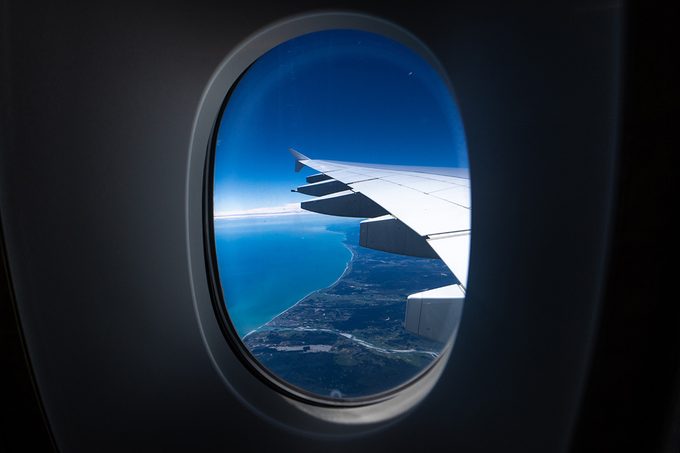It's not about beautiful design—but rather the result of a series of high-stakes, hard-earned lessons in aviation history

Here’s Why Airplane Windows Are Round Instead of Square

Mention windows on a plane to most travelers, and their minds usually jump to the age-old debate: window or aisle? (For me, the answer is quite obviously window.) But the topic curves in a different direction when you consider another window-related detail that often goes unnoticed—the shape.
Airplane windows are rounded, and while that soft curve is pleasing design-wise, it might leave you wondering if square windows could offer passengers a more expansive view.
We went straight to Wayne Maltry, a consulting engineer at Engineering Design & Testing Corp. whose areas of expertise include aircraft crash and aircraft component failure investigations, to pose the question: Why are airplane windows round? As it turns out, there’s a very important reason for their particular design. It has less to do with aesthetics and more to do with a dark chapter in aviation history—and the crucial fix that keeps us safer in the skies today. Keep reading to find out why airplane windows are round.
Get Reader’s Digest’s Read Up newsletter for more travel, fun facts, humor, cleaning and tech all week long.
What shape were airplane windows before they became rounded?
According to Maltry, in the early days of commercial aviation aircraft development, fuselage windows were square. The reason? To facilitate the ease of manufacturing and installation. “No one was wise to the inherent hazard associated with square windows,” Maltry says.
Why were square windows reconsidered?
A series of high-profile crashes involving commercial jet airliners forced the industry to figure out what was happening. In less than one year, three De Havilland Comets operated by British Overseas Airways Corporation crashed: one after taking off from Calcutta, India, in May 1953; another off the coast of Italy in January 1954; and a third in April 1954 after departing Rome. “A subsequent crash investigation revealed that the fuselage ruptured from cabin pressurization applied to fuselage fractures that propagated from a front top square window corner,” Maltry says.
Why are modern airplane windows round?

Quite simply, for one main reason: they’re stronger and won’t crack. Maltry explains that after the crashes in the 1950s, windows were “rounded to reduce the stress at these window corners and prevent development of fatigue cracks.”
He continues, “Airplane windows are round for the same reason space, ocean and submarine ship hull portals are rounded—to reduce stress concentrations under the influence of pressurization cycles and the opportunity for microscopic crack and macroscopic fracture development.”
How do rounded windows avoid the issue?
“Sharp corners experience higher material stresses than rounded corners do when the structural component they are a part of is exposed to external forces, such as pressurization that a sealed container can produce,” Maltry says. That’s why, in nearly all structural designs, sharp corners are rounded or filleted (the “t” is pronounced), to reduce stress.
In an aircraft fuselage, which constantly undergoes cycles of pressurization and depressurization, even microscopic cracks can slowly grow and spread over time. “Prolonged elevated stress exposure increases the rate at which material fatigues,” he notes.
If a fracture becomes large enough to breach the fuselage, it can lead to rapid cabin depressurization. Once that happens, the aircraft may lose its structural shape, and an implosion occurs, which damages the aircraft’s form and makes it unable to fly as it should. “The result is a loss of aircraft control that can result in a crash,” Maltry says.
Are there any other functional or aesthetic benefits to rounded windows?
Not really—the shape is all about getting travelers to their destination without incident, not provide them with great views along the way. Rounded windows actually increase the cost of fuselage manufacture because of the extra complexity involved. But safety is the top priority. “Passengers aren’t likely to notice the difference between square, rounded corner or [fully rounded] windows,” Maltry says.
RELATED:
- Here’s Why Flight Attendants Might Sit on Their Hands During Takeoff and Landing
- Here’s What It Means If You See Green Fluid on an Airplane Wing
- What REALLY Happens to Those Airplane Blankets and Pillows?
About the expert
|
Why trust us
Reader’s Digest has published hundreds of travel stories that help readers explore the world safely, easily and affordably. We regularly cover topics such as the best places to visit (and the best times to visit them), tips and tricks to zoom through airport security, flight-attendant secrets, hotel-room hacks and more. We’re committed to producing high-quality content by writers with expertise and experience in their field in consultation with relevant, qualified experts. We rely on reputable primary sources, including government and professional organizations and academic institutions as well as our writers’ personal experiences where appropriate. We verify all facts and data, back them with credible sourcing and revisit them over time to ensure they remain accurate and up to date. Read more about our team, our contributors and our editorial policies.
Sources:
- Wayne Maltry, consulting engineer at Engineering Design & Testing Corp.; email interview, June 2025
- The Guardian: “Midair Collisions to Metal Fatigue: Tragedies That Changed Air Travel”























